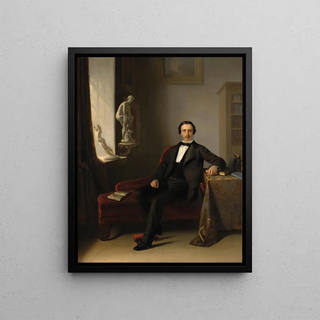Art print | Abraham Willet 1825-1888 - Johann Georg Schwartze


View from behind

Frame (optional)
Abraham Willet 1825-1888 - Johann Georg Schwartze – Engaging introduction
The art print of Abraham Willet 1825-1888 - Johann Georg Schwartze is part of a timeless dialogue between art and history. This piece, although dating from the 19th century, manages to capture the essence of an era while resonating with the modern viewer. By exploring this work, we discover not only Schwartze's technical virtuosity but also the stories and emotions behind the portrait of this man, Abraham Willet. The depth of the gaze and the richness of the details invite contemplation that transcends mere visual appreciation, transporting the observer on a journey through time and space.
Style and uniqueness of the work
Johann Georg Schwartze's style is imbued with refined elegance, characterized by striking realism and meticulous attention to detail. In this art print, each brushstroke appears to have been chosen with care, revealing a palette of colors that evoke both warmth and gravity. Light plays a leading role, illuminating Willet's face in a way that accentuates his features while creating an almost tangible atmosphere. The composition is balanced, offering a perspective that draws the eye toward the subject's face, while hinting at elements of his environment, thus reflecting his status and era. This stylistic approach makes Schwartze a master of portraiture, capable of capturing not only appearance but also the soul of his subjects.
The artist and his influence
Johann Georg Schwartze, a German-born painter, established himself on the 19th-century art scene through his mastery of portraiture. Trained in academic traditions, he combined technical rigor with artistic sensitivity. His work, influenced by the great masters of the past, stands out for its ability to bring human emotions to life. Schwartze had a significant impact on his contemporaries, inspiring a new generation of artists to explore the narrative potential of the portrait. As a witness to his time, he also contributed to documenting important figures of society, making his work a valuable historical record. Through his portraits, he succeeded in establishing a

Matte finish

View from behind

Frame (optional)
Abraham Willet 1825-1888 - Johann Georg Schwartze – Engaging introduction
The art print of Abraham Willet 1825-1888 - Johann Georg Schwartze is part of a timeless dialogue between art and history. This piece, although dating from the 19th century, manages to capture the essence of an era while resonating with the modern viewer. By exploring this work, we discover not only Schwartze's technical virtuosity but also the stories and emotions behind the portrait of this man, Abraham Willet. The depth of the gaze and the richness of the details invite contemplation that transcends mere visual appreciation, transporting the observer on a journey through time and space.
Style and uniqueness of the work
Johann Georg Schwartze's style is imbued with refined elegance, characterized by striking realism and meticulous attention to detail. In this art print, each brushstroke appears to have been chosen with care, revealing a palette of colors that evoke both warmth and gravity. Light plays a leading role, illuminating Willet's face in a way that accentuates his features while creating an almost tangible atmosphere. The composition is balanced, offering a perspective that draws the eye toward the subject's face, while hinting at elements of his environment, thus reflecting his status and era. This stylistic approach makes Schwartze a master of portraiture, capable of capturing not only appearance but also the soul of his subjects.
The artist and his influence
Johann Georg Schwartze, a German-born painter, established himself on the 19th-century art scene through his mastery of portraiture. Trained in academic traditions, he combined technical rigor with artistic sensitivity. His work, influenced by the great masters of the past, stands out for its ability to bring human emotions to life. Schwartze had a significant impact on his contemporaries, inspiring a new generation of artists to explore the narrative potential of the portrait. As a witness to his time, he also contributed to documenting important figures of society, making his work a valuable historical record. Through his portraits, he succeeded in establishing a






